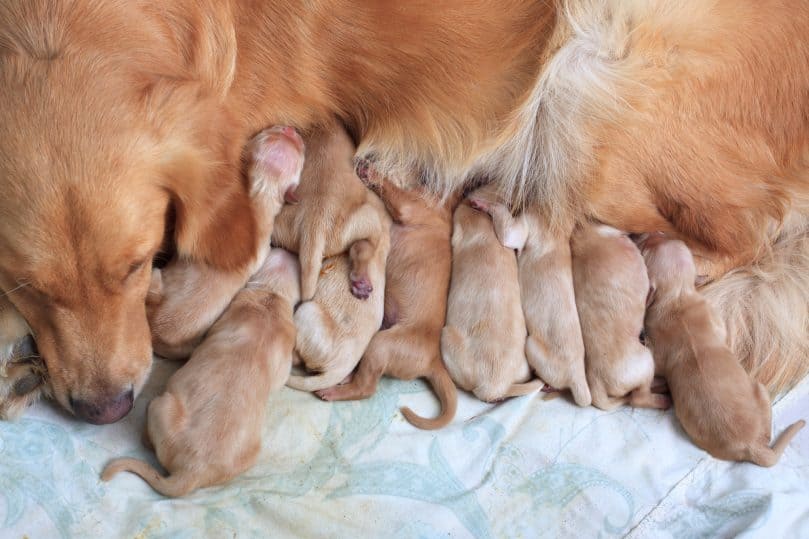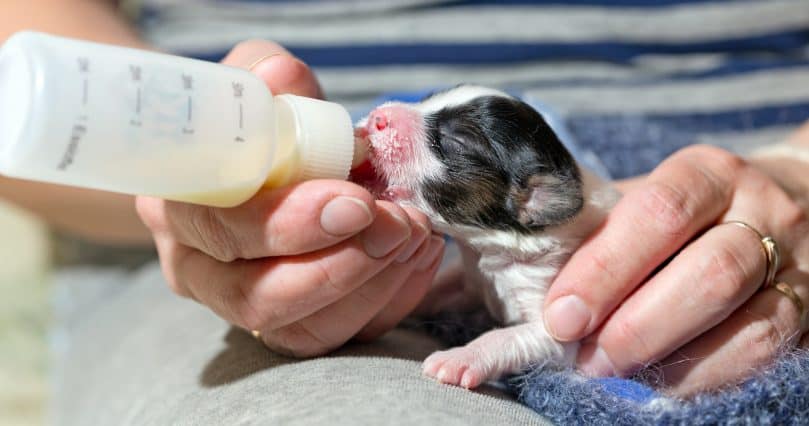This page contains affiliate links. We may earn money or products from the companies mentioned in this post through our independently chosen links, which earn us a commission. Learn More
 Fading puppy syndrome is a term used to describe a puppy dying for unknown reasons shortly after it is born, with no clinical signs, or any clear cause of death. This syndrome, also known as failure to thrive, might happen anytime during the first week or even after ten weeks.
Fading puppy syndrome is a term used to describe a puppy dying for unknown reasons shortly after it is born, with no clinical signs, or any clear cause of death. This syndrome, also known as failure to thrive, might happen anytime during the first week or even after ten weeks.
Breeders and dog owners would do anything to take care of their pregnant dog. And of course, you’d do everything to make sure all her puppies are okay.
But there’s always the possibility that some pups will make it, and others won’t. So, why do some puppies die all of a sudden? One thing’s for sure, it’s not a diagnosis, and there are a lot of reasons behind it.
Contents & Quick Navigation
What’s fading puppy syndrome?
This is not just a term, but more of a catch-all phrase. It is used to describe neonatal puppies that are born healthy but gradually fade and die of uncontrollable and unknown causes.
Fading puppy syndrome is most common during the first week of life, but may occur up until ten weeks of age.

Is fading puppy syndrome inherited or genetic?
No, it’s not. Newborn puppies, or most mammals, are vulnerable creatures since they are born with incomplete immune systems. Since they are born blind and deaf, they rely on their instinct and sense of smell to learn to feed.
The litter would rely on passive immunity to survive. Puppies are not capable of developing resistance to illnesses on their own that they will need an external source to thrive.
Dogs have their own, natural way to grant passive immunity to their puppies.
Although the pups get little to no antibodies while developing inside the womb, they would need to absorb essential nutrients by drinking their mother’s milk called colostrum. It’s the first milk that the mother dog produces after whelping.

One of the colostrum’s principal functions is to pass the bitch’s maternal antibodies to the puppies and boost their immune system. It will also help them to fight illnesses until they get the necessary vaccinations they need.
As a breeder, your goal is to get each puppy to nurse within their first 24 to 48 hours of life. This stage is when their intestinal lining would be able to absorb it best.
Once a fading puppy (also known as fader or runt) “misses” his or her golden window to ingest colostrum, then the risk is getting higher. You’d even be playing catch up with intensive care and tools that are not 100% proven to help the pup.
Symptoms: What are the signs of fading puppy syndrome?
The clinical signs in a fading puppy are insidious and vague. Once the symptoms are apparent, it’s often too late for you to save the little pup.
The common and noticeable signs are weight and decreased activity.

It’s either the puppy came out with low birth weight or is not gaining weight at the same rate as its siblings. The runt is also not that active and has trouble latching.
Faders also tend to separate themselves from their mother and other pups. They’re also criers in a weak, high-pitched tone that some refer to as seagulling (since it’s similar to a seagull’s cry).
Most of the time, fading puppies progress quickly to the loss of muscle tone, severe lethargy, and death.
Causes: Why does fading puppy syndrome happen?
There are numerous reasons why a puppy “fade.”
Aside from immune systems that aren’t fully functioning, limited protection from infections, and being unable to regulate their temperature and fluid, here are some other causes:
- Chilling
- Constipation
- Congenital abnormalities
- Hypoglycemia (low glucose levels in the blood)
- Insufficient maternal care
- Lack of milk production or poor quality of milk
- Infectious causes such as septicemia.
- Complications and trauma during the birth process that can affect a puppy
- Low birth weight

Since puppies would rely on their mother for colostrum, it’s crucial to have her examined immediately after whelping.
The vet would check for any abnormal discharge, mastitis (breast infection), metritis (urine infection), or other illnesses that would affect her offspring.
Viral infections such as canine parvovirus can also cause fading puppy syndrome.
If the mother dog isn’t appropriately vaccinated or is carrying a virus, the pups can contract the infection from her.
The Big Four
Some of the most common reasons behind early neonatal death are called the Big Four: E-Coli, Streptococcus, Staphylococcus, and Herpesvirus.
Most puppies are exposed to these infections, whether in the birth canal or after they’re born. Staph, strep, and E-Coli do occur naturally in the birth canal of a healthy mother dog. Even their umbilical cords are hosts for bacteria.
You can give all your effort in making sure that you provided your female canine a clean whelping area. But it’s not possible to give her and the puppies a genuinely sterile environment.
That means fading puppy syndrome can be congenital or infectious.
If it’s infectious, then it’s more concerning since it can put the other members of the litter in danger.

If it is congenital, then the runt can be underdeveloped at birth or has a congenital disability. These two types usually overlap since the mother would often fail to care for small or weak puppies.
Diagnosis and Treatment: Can you save a fading or dying puppy?
It is possible. Bring your pup to a veterinarian right away if you notice that a puppy is:
- not growing at the same rate as its siblings
- not latching
- always crying
- always trying to separate itself
The vet will do a physical examination for birth deformity, signs of infections, or other problems.
They’d also have to get blood, urine, and feces samples.
Aside from those, be prepared with the medical history of the mother and the father of the puppies. That includes a record of recent vaccinations and pregnancies.
Your vet would need to examine the dam to see if there are signs of uterine or breast infection.
Glandular problems may have affected the quality and quantity of her milk.
To make sure the veterinarian did not miss anything, they would also have urine tests and blood work done for the mother dog.
If the puppy has low body temperature, the vet will have to warm the pup back to its average body temperature slowly. It can last for several hours to avoid shocking the puppy’s system.
The puppy won’t be allowed to eat if the body temperature is lower than normal and has no nursing reflex. But once it’s warmed, the pup is then encouraged to try nursing.
Intravenous fluid therapy and oxygen supplementation will be provided to correct fluid deficits.
For cases where the runt has hypoglycemia, you will need to use fluids with glucose for the therapy.
The puppy needs to go under antibiotic therapy if bacterial infections are present.
But most of the time, death happens too quickly for diagnosis and treatment to take place. It’s a good idea to have a posthumous examination for the puppy anyway.
The exam will help see what caused fading puppy syndrome since some conditions can affect other members of the litter.
How to help a pup with fading puppy syndrome
The best thing you can do is care for the runt or fader with the veterinarian’s help or advice. Although good home care will give him or her the best chance of recovering and surviving, it’s still crucial to have the puppy checked.
Always follow the guidelines to make sure that the puppy is adequately fed and medicated at home.
It’s very crucial to give medications at the exact time and prescribed dosage due to the pup’s immature stage. Even small changes in dosage can be dangerous to the puppy’s recovery.
Faders who are under therapy should be fed and medicated at a frequency specific to their size, age, and breed.
Their needs are relatively simple – heat, calories, and fluids to support the puppy for the first 2-4 days of its life.
So, proper care of the puppies and their surrounding and strict hygiene is also critical.

And make sure that the fading puppy has its own box that has a heating pad and is partially covered.
Help the puppy find a comfortable spot by providing different amounts of padding over the heating pad on different parts of the box.
The most effective technique that you can do if you need to provide water and sugar is by injecting subcutaneous fluids. You’ll have to insert it under the skin on top of the neck of the puppy every 2 hours.
You must talk to your vet about this so that you can be instructed on how to do this safely.
The fluid is dextrose in saline to prevent dehydration and provide energy since the dextrose part is sugar.
This method will help satisfy any fluid requirements in a dehydrated pup. You can also leave a repository of fluid for the puppy to draw on for the next two hours.
Aside from managing other vital factors such as stimulation to urinate and defecate, any pup undergoing this technique should be strong enough after 48 hours. The puppy would be able to rejoin the litter!
Just watch this video on how SubQ fluids are injected in fading puppies, how to take their temperature, and how to feed them:
Give a drop of Karo syrup to the puppy every couple of hours. After 5 minutes or so, place the puppy on the mother dog’s nipple to nurse.
Choose a good nipple where other puppies won’t get in the way while the recovering pup tries to latch. You can place the rest of the litter in a box or crate and leave them aside for as long as the fading puppy will nurse.
If you’re using oxytocin, put the fader or slow gaining puppy on its mom for at least 15 minutes after taking its oxytocin shot.
Are you thinking or were advised to tube the puppy? Don’t! Read on why you shouldn’t feed newborn puppies using a tube.
Preventing fading puppy syndrome
Prevention is better than cure – this is a famous saying that also applies when taking care of our dogs. To avoid risking the health and life of the puppies, we should make sure that we’ve done our part in taking care of our female dog, their mother.
From the moment you decide to breed her to choosing a mate, and from your bitch’s overall care to the pregnancy and giving birth.
Keep in mind that each stage and event in your dog’s life would have an impact on her future offspring.

If you currently have newborn puppies to take care of, they need to get colostrum from the mother dog within their first 12 hours of life. If necessary, express the milk from the bitch’s breasts and feed a fader using a dropper.
Practicing cleanliness and proper management of your dog and her offspring will go a long way in avoiding losing a puppy to fading puppy syndrome.
Do you have other advice for new dog owners or breeders on how to deal with a fader or fading puppy? Just leave a comment on the box below!

5 replies on “Fading Puppy Syndrome: Prevention and Treatment”
Hi my name is Katie, we have a little girl (coco) Pomeranian who has just a week ago had three puppies all doing great two boys gaining weight massively and girl was also until 3 days ago she dropped from 10.9oz back down to day twos weight of 8.6 oz, since then I have taken her on as she wasn’t suckling and was weak and lifeless I have religiously fed 2 hourly a ml of formula to her oz of weight, she is now 9.1oz dropping and gaining frequently I have been giving liquid glucose thinking it could be hypoglycaemia she is warmed and I am doing everything I can for her…
I have taken her the vets who seems to think she has a lump in her abdomen I’m a nurse and cannot feel this she said she will not be urinating or opening her bowels because of this then to her surprise she pooped on the table and urinated on her which she is doing regularly and of a normal consistency to which she made comment on euthanasia which I will never do she is trying to stay alive and I will too.. she drinks from a syringe and will also sickle although it’s weak and too weak to suckle from mum I have tried keeping her with mum as much as I can do she can clean her ect
How long can fading go on for? Does this sound like that situation or would you say more just being the runt of litter and needs extra care I can’t see any massive improvements and not sure what else I can do …
any help is appreciated and thankyou for your time.
Regards katie
Get Outlook for iOS
Thank you!
Light or dark Karo Syrup?
always have milk replacer on hand before your puppies are born just in case you have an emergency do you already have it also make sure to have a nice clean area that is out of the way how’s traffic in your house so the dog is comfortable is not in a noisy part of your house make sure that your house is kept at a good temperature so the puppies do not get cold good luck on your newsletter
Hi,
Please don’t judge me for this question as I’m devastated & very fragile right now over this.
My friend’s British bulldog recently had pups, there was a runt and the other pups were healthy, I went to help my friend who was overwhelmed at the beginning when the pups were a few days old for 2 hours with the pups & also did some gardening for her that day. I was diligent with my hand hygiene while handling the pups.
The pups were in the whelping box & I tried many times to latch the runt who subsequently died a few days later.
Since then a few more puppies have died from fading puppy syndrome & now the blame has been laid square on me because I mentioned that my own healthy little dog who I do love & care for wasn’t up to date with her vaccinations or worming tablets, (she is now).
I have been blamed for the death of the puppies and made to feel I’m the cause & scapegoat. I was not the only person to handle the pups at a young age, plenty of others handled them too after I was there.
Is it possible that if my dog had worms at the time, which I’m sure she didn’t, that I could have carried that to the puppies, an autopsy of one has revealed it had worms even though the pups were wormed very early & on antibiotics.
So many of my online searches say that dogs can transmit worms to humans but I cannot find any to say that humans can transmit worms to a dog.